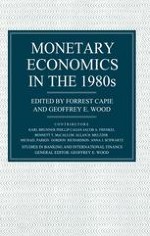1989 | OriginalPaper | Chapter
A Century of British Market Interest Rates, 1874–1975
Author : Anna J. Schwartz
Published in: Monetary Economics in the 1980s
Publisher: Palgrave Macmillan UK
Included in: Professional Book Archive
Activate our intelligent search to find suitable subject content or patents.
Select sections of text to find matching patents with Artificial Intelligence. powered by
Select sections of text to find additional relevant content using AI-assisted search. powered by
Henry Thornton left a spare account — best described by the Latin phrase,
multum in parvo
, ‘much in little’ — of his thoughts about the British monetary system during the Napoleonic era. That spare account is an incredibly rich source both of the elements of monetary theory and of instruction on the proper conduct of monetary policy. Any one of a dozen different insights recorded in Thornton’s work could serve as the subject of this lecture. He understood:
the fallacy of the real-bills doctrine; the distinction between the first-round and ultimate effects of monetary change; the lag in effect of monetary change; the problem market participants faced in distinguishing relative from general price changes; the distinction between internal and external gold drains; the factors influencing the foreign exchanges including the role of purchasing power parity; how to bring inflation under control; the relation of the Bank of England to other English banks; types of effects of monetary disturbances on interest rates; the distinction between the market rate and the natural rate of interest and between nominal and real rates of interest.
